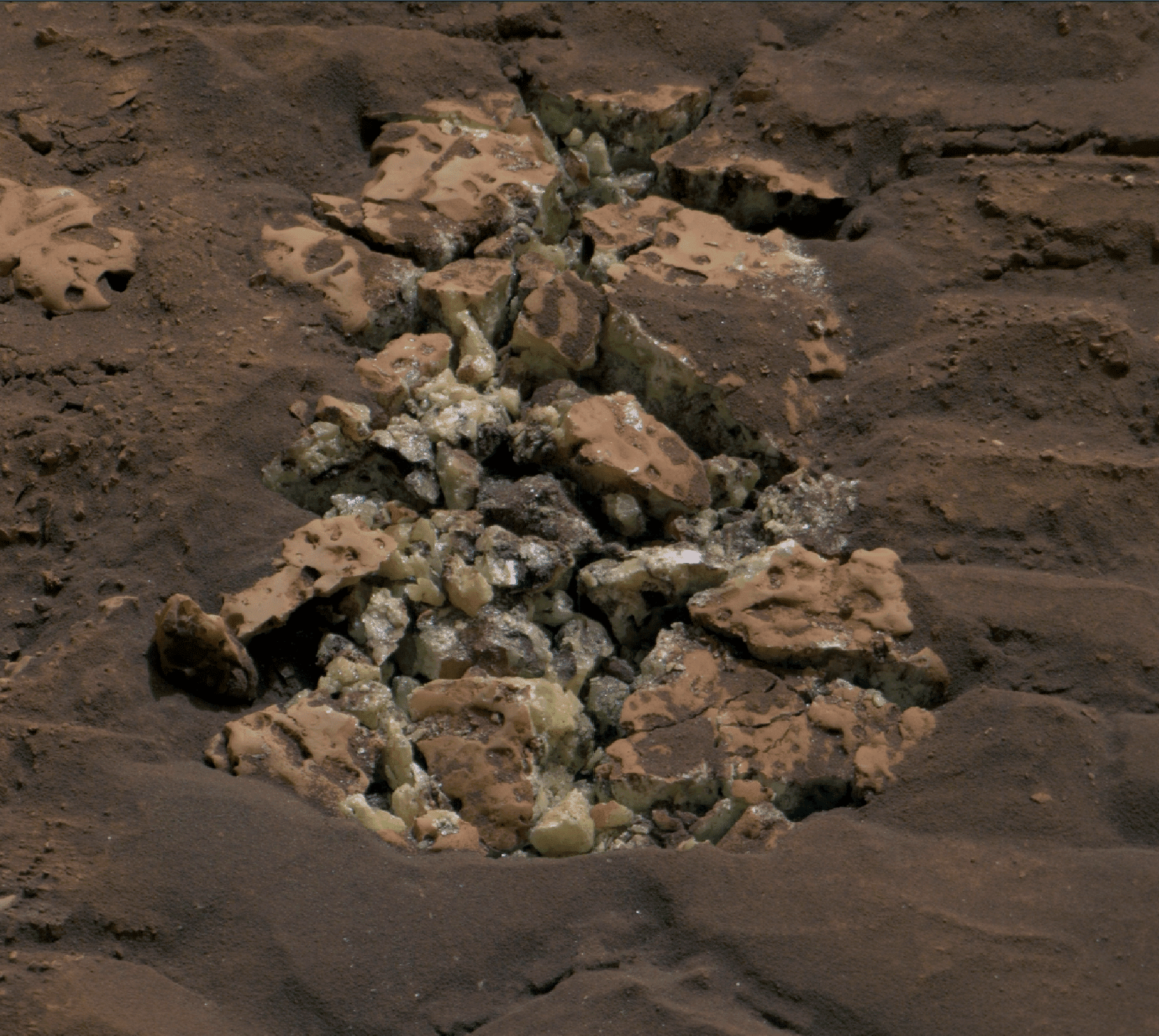Scientists were amazed when a rock the Curiosity rover was driving over cracked, revealing something never before seen on the Red Planet: yellow sulfur crystals.
Since October 2023, the Curiosity rover has been exploring a region of Mars rich in sulfates, a type of salt that contains sulfur and forms when water evaporates. However, researchers were very surprised when they took a closer look at a rock that Curiosity accidentally broke open. Unexpectedly, Curiosity found rocks made of pure sulfur, unique to the Red Planet.
yellow sulfur crystals
Below you can see an image of yellow sulfur crystals. While previous discoveries have included sulfur-containing minerals—that is, a mixture of sulfur and other materials—the rocks shown below are composed of elemental, or pure, sulfur. It remains unclear what, if any, relationship this pure sulfur has to other sulfur-containing minerals in the area.

Sulfur
Fortunately, Curiosity doesn’t have to put its nose near the yellow sulfur crystals. Although sulfur is often associated with the smell of rotten eggs (due to hydrogen sulfide gas), pure sulfur is odorless. What’s striking is that it forms under a limited set of conditions that scientists hadn’t previously linked to the site’s history. What’s more, Curiosity found a lot of it: It was scattered across a field of shiny rocks similar to the ones the rover had just passed.
oasis
The mission members can’t believe their luck. “Discovering a field of pure sulfur rocks is like finding an oasis in the desert,” explains mission member Ashwin Vasavada. “It really shouldn’t be there, so now we have to figure out how it got there. Finding such strange and unexpected things is what makes planetary exploration so exciting.”
Discoveries
The discovery of yellow sulfur crystals can be added to Curiosity’s already impressive list of discoveries. As it explores the Geddes Vallis Channel, a trench that runs along part of the five-kilometer-high Mount Sharp that the rover has been climbing to its base since 2014, it has already encountered several surprises. Each layer of the mountain represents a different period in Mars’ history. Curiosity’s mission is to explore where and when the planet’s ancient surface might have provided the nutrients needed for microbial life, if life ever existed on Mars.
Geddes Valles Channel
The Gediz Vallis Canal was spotted from space years before Curiosity launched, and it’s one of the main reasons the science team wanted to explore this part of Mars. Scientists believe the canal was formed by flows of liquid water and debris, leaving a trail of rocks and sediments that stretches about two miles down the mountainside below the canal. The goal is to better understand how this landscape has changed over billions of years. While the recent discoveries have been enlightening, there’s still much to learn from this impressive landscape.

large piles of rubble
Since Curiosity arrived in the channel this year, scientists have been investigating whether floods or ancient landslides are responsible for the large debris piles rising from the channel floor. The latest data from Curiosity suggest that both factors played a role: Some of the mounds were likely formed by intense water and debris flows, while others may be the result of more localized landslides. These conclusions are based on the stones in the mounds: The stones carried by the water streams are often rounded, like river stones, while some of the mounds are filled with more angular stones that may have been deposited by dry avalanches.
water
Eventually, the water spread through all the sediment here. Chemical reactions with the water created white “halo” patterns in some of the rocks. Erosion from wind and sand created these halo patterns over time. “This was not a quiet time on Mars,” says researcher Becky Williams. “We see a variety of flows through the channel, including strong floods and debris-laden flows.” In short, these results suggest that Mars was a much more active planet in the past than previously thought, with periods of violent flooding and landslides shaping its landscape.
mammoth lakes
All this water evidence reveals a more complex story than the team initially anticipated. So they were eager to get a rock sample from the channel to find out more. Although the sulfur rocks were too small and fragile to sample with a drill, a large rock called “Mammoth Lakes” was found nearby. The mission members had to find a suitable section of rock to safely drill into and a suitable spot on the soft, sloping surface to stand on. After Curiosity drilled its 41st hole using the powerful drill at the end of its two-meter-long robotic arm, the crushed rock was collected in the rover’s instruments for further analysis. This allows scientists to determine what the rocks are made of.
Overall, Curiosity’s discoveries in the Geddes Vallis Canal have greatly deepened our understanding of Mars’ geological history. Each new discovery brings scientists closer to resolving the question of whether Mars ever had the conditions necessary for microbial life. Curiosity has now left Mammoth Lakes and is on its way to see what other surprises await in the canal.

“Coffee buff. Twitter fanatic. Tv practitioner. Social media advocate. Pop culture ninja.”











More Stories
Which can cause an increase in nitrogen.
The Central State Real Estate Agency has no additional space to accommodate Ukrainians.
The oystercatcher, the “unlucky national bird,” is increasingly breeding on rooftops.